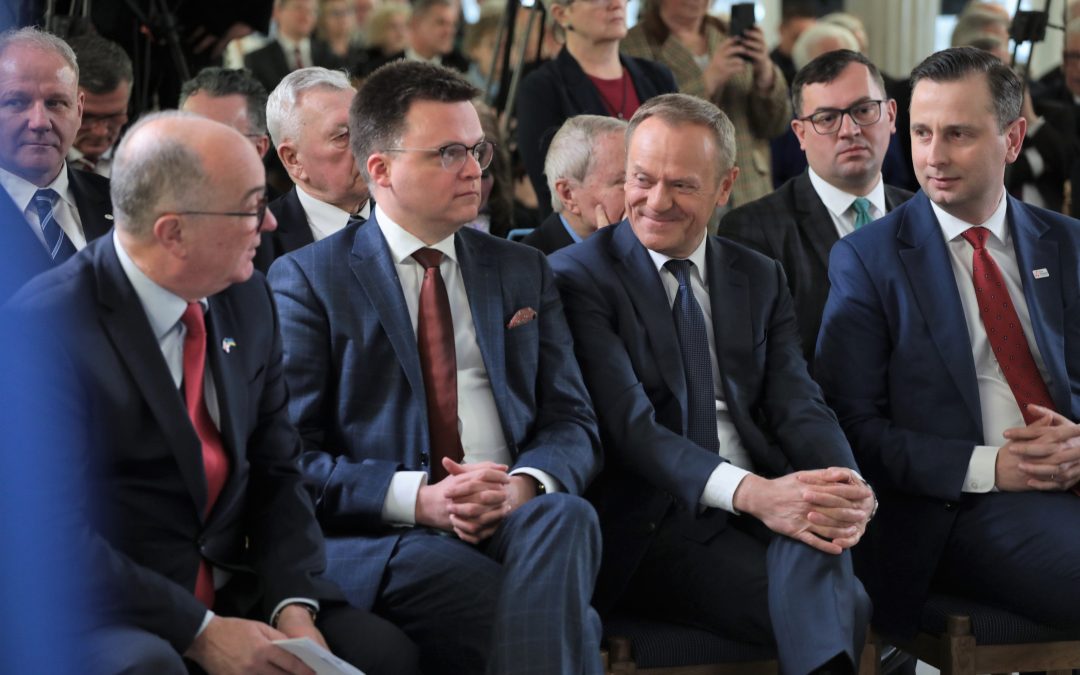By Aleks Szczerbiak
Although opposition parties know that contesting the next election as separate lists favours the right-wing incumbent, a single united bloc remains extremely unlikely given their diverse electorates and because it would mean accepting the largest grouping’s hegemony. Most have adopted a wait-and-see approach, and final decisions about the configuration of opposition lists may not be taken until next spring.
Four main opposition parties
In recent weeks there has been a vigorous debate as to whether Poland’s opposition should contest the next parliamentary election, scheduled for autumn 2023, as a single joint list.
In addition to the radical-right Confederation (Konfederacja), the opposition currently comprises four main parties. The most popular of these is the liberal-centrist Civic Platform (PO), which was Poland’s main governing party between 2007-15.
PO’s leader is former European Council President Donald Tusk, who was prime minister between 2007-14 and took over the party leadership after returning to front-line Polish politics last summer. According to the “Pooling the Poles” micro-blog that aggregates voting intention surveys, PO is currently averaging 29% support compared with 36% for the right-wing Law and Justice (PiS), Poland’s ruling party since autumn 2015.
Poland 2050 (Polska 2050), a new liberal-centrist party formed by TV presenter-turned-politician Szymon Hołownia after his strong third place in the summer 2020 presidential election, is currently running third with 11% support.
Averaging 10% is The Left (Lewica), which comprises the New Left (Nowa Lewica) party – formed last year following a merger of the communist successor Democratic Left Alliance (SLD), Poland’s governing party between 1993-97 and 2001-5, and liberal-left Spring (Wiosna) led by sexual minorities campaigner Robert Biedroń – and the radical-left Together (Razem) grouping.
Finally, the agrarian-centrist Polish People’s Party (PSL), which is the organisational successor to a communist satellite grouping but has attempted to legitimate itself by claiming roots in the pre-communist agrarian movement which dates back to the nineteenth century.
Although the PSL was in coalition with the SLD in the mid-1990s and early 2000s, it was also PO’s junior governing partner. It contested the most recent autumn 2019 parliamentary election at the head of the centre-right Polish Coalition (Koalicja Polska) electoral alliance but is currently hovering around the 5% threshold for parties to secure representation in the Sejm, Poland’s more powerful lower parliamentary chamber.
A ‘unity premium’?
Tusk, in particular, has been trying hard to convince the other parties to contest the next election as a single list. Supporters of this option argue that not only would the combined opposition vote be more than enough to defeat PiS.
They also say that a single list would actually help the opposition to win extra seats given that the Polish electoral system – proportional representation in multi-member constituencies, with mandates allocated using the d’Hondt counting method – favours larger groupings, especially if a united bloc prevented smaller parties from falling below the parliamentary representation threshold.
In the 2015 election, for example, PiS secured an outright majority in spite of winning only 38% of the vote because left-wing parties failed to secure parliamentary representation.
Moreover, supporters of a single list argue that, in addition to electoral system rewards, the opposition could also secure a dynamic “unity premium” as anti-government voters were mobilised by the knowledge that they would be voting for a bloc with a strong chance of winning (although the greater polarisation could also mobilise PiS voters).
Tusk, for example, cited a May poll conducted by the Ipsos agency for the liberal-left OKO.press portal which showed that 50% of respondents would vote for a single opposition list, 20% more than for PiS (although critics point out that the findings assumed an 88% turnout when in 2019 it was only 62%, itself a record high for a post-1989 parliamentary election).
More cynical commentators argue that part of the motivation for a single opposition list is to actually dilute the prominence of Tusk who, although he is popular among government opponents, is one of Poland’s least trusted politicians.
While his return to domestic politics re-established PO as the main opposition grouping, the party still lags behind PiS, and a June-July survey by the CBOS agency found that only 30% of respondents trusted him while 52% did not.
Given that Tusk was prime minister for nine out of the ten years that PO was in office, few politicians better embody the previous administration, which came to be viewed by many Poles as lacking social sensitivity and out-of-touch with their needs.
Opposing Law and Justice is not enough
However, the leaders of the other opposition parties, especially Poland 2050 and PSL, are much less enthusiastic about the idea of a single list. Their main argument is that, while the opposition may be united in their dislike of PiS, evidence suggests that their electorates are quite heterogeneous and it will be difficult to get such a diverse group of Poles to support a single list.
Indeed, critics argue that a single list strategy could actually lose the opposition voters on its ‘flanks’, and be undermined by those who reject the current duopoly and would support ‘challenger’ parties instead.
There will, for example, be moderate centre-right voters who may not support PiS but could be put off voting for a joint opposition list that contains parties with a strong liberal-left ideological profile on moral-cultural issues; including, for example, many of PSL’s small-town, socially conservative supporters.
Similarly, Poland 2050 has attracted some support through its claim to transcend the “pro-versus-anti-PiS” binary divide, but it will be difficult for the party to present itself as “new” if it enters into a pre-election coalition dominated by PO which, to many voters, embodies the pre-2015 status quo ante.
Interestingly, an August 2021 CBOS survey found that only 36% of Poland 2050 and 45% of PSL voters identified themselves as opposition sympathisers compared with 57% of The Left and 70% of PO supporters.
Opponents of the single list idea point to the experience of the European Coalition (Koalicja Europejska) when virtually all of the opposition came together to form an alliance specifically to contest the May 2019 European Parliament election.
In the event, PiS secured 45% of the votes, ahead of the Coalition with only 38%, less than the combined support of the parties comprising the bloc when it was formed.
Critics also point to April’s Hungarian election, where a single opposition list spanning left-to-right saw its early poll advantage crumble and the incumbent right-wing Fidesz party secure a landslide victory by drawing attention to its opponent’s programmatic incoherence.
These examples highlight one of the key problems with a single list: that, unless the PiS government implodes or is completely discredited, opposition to the ruling party is not, on its own, a powerful enough mobilising appeal, but the opposition’s ideological eclecticism makes it difficult to develop a clear and distinctive programmatic message.
Supporters of a single list counter that, in spite of their differences, the four anti-government parties’ electorates have more in common than divides them, pointing to how in autumn 2019 they rallied to overturn PiS’s majority in the Senate, Poland’s less powerful second chamber whose members are elected in single-member constituencies.
They argue that, because the Polish electoral system is based on “open” candidate lists, voters can support their preferred party even within a single opposition bloc (although this ignores the fact that most voters simply support the candidates at the top of the list, who thereby define the grouping’s overall political profile).
Comparisons with the 2019 European election are, they say, erroneous as the European Coalition only failed because it did not manage to unite the whole opposition. They also argue that there were particular circumstances explaining why the Hungarian opposition lost so heavily to Fidesz (until the Russian invasion of Ukraine they were running neck-and-neck) and its result would have been even worse if it had run as separate party lists.
Who aligns with Civic Platform?
The opposition parties know that contesting the next election as four separate lists strongly favours PiS, so self-interest will, sooner or later, probably incline them to be more flexible in their approach to forging electoral alliances.
But there is less agreement about what the optimal opposition configuration should be. A single opposition list remains extremely unlikely given the anti-PiS camp’s ideological diversity, and because it would mean the other parties accepting PO’s hegemony. So the key questions are: which parties will join together on which lists, and (in particular) who aligns with PO?
The greatest electoral system benefits would probably come if PO ran separately and the three smaller groupings came together in an electoral bloc but, for the reasons discussed, it would be very difficult to bring together PSL in a joint list with The Left.
While PO would probably feel most comfortable in an alliance with PSL and Poland 2050 (leaving The Left to run separately), these two groupings would prefer not to be aligned with Tusk’s party.
Their leaders argue that the most promising approach is to have one “centrist” opposition list comprising these two parties, and a second that comprises PO and The Left.
Two blocs (KO+Lewica and PSL+Polska 2050) would win the most seats among four potential opposition configurations, finds a Kantar poll for @gazeta_wyborcza https://t.co/J3YayPWAFI pic.twitter.com/2oZsSca2I4
— Daniel Tilles (@danieltilles1) June 13, 2022
They cite the example of last October’s Czech election, when two opposition blocs, one centre-right and one liberal, ousted the incumbent government headed by controversial billionaire Andrej Babiš, and a May United Surveys poll conducted for the RMF FM radio station which appeared to confirm that such a configuration would actually be more effective than a single list.
Certainly, Poland 2050 and PSL, joined by smaller liberal-conservative groupings and defectors from PiS and PO, would appear to be the most natural fit for a joint list. However, Hołownia remains wary of undermining his party’s appeal to “newness” by teaming up with a party that for many is still associated with the post-communist establishment.
A joint PO list with The Left is certainly feasible. Although relations between the two groupings’ leaders were particularly bad when the latter suspected Tusk of sponsoring a pro-PO left-wing breakaway party, they now appear to have declared a truce.
Nonetheless, although in recent years PO has shifted to the left on both socio-economic and moral-cultural issues, sections of The Left, particularly supporters of Together, have considerable misgivings about running on a joint list with a party that they believe is still rooted in a conservative-liberal mindset.
For its part, PO retains ambitions to draw support from across the political spectrum, and is concerned that building an alliance solely with The Left could put off moderate conservative voters.
No final decisions until next spring?
At the moment, the most likely configuration appears to be three opposition lists: PO; Poland 2050 with PSL and smaller liberal-conservative groupings; and The Left.
Some analysts feel this might even be a sufficient level of consolidation, given that the biggest electoral system “unity premium” comes from the smaller parties combining to ensure that their votes are not “wasted”, with the benefits of then joining a larger grouping being incrementally smaller.
But the situation is very fluid and, with over a year to go until the election, most opposition leaders feel that they can wait and see how the situation develops during the next few months. Hołownia, in particular, is keen to leave it until the last moment to join a coalition as he feels that he needs to carve out the best possible position for his new party.
Indeed, it could be that final decisions on the configuration of the opposition lists will not be taken until as late as next spring.
Main image credit: Slawomir Kaminski / Agencja Wyborcza.pl





















